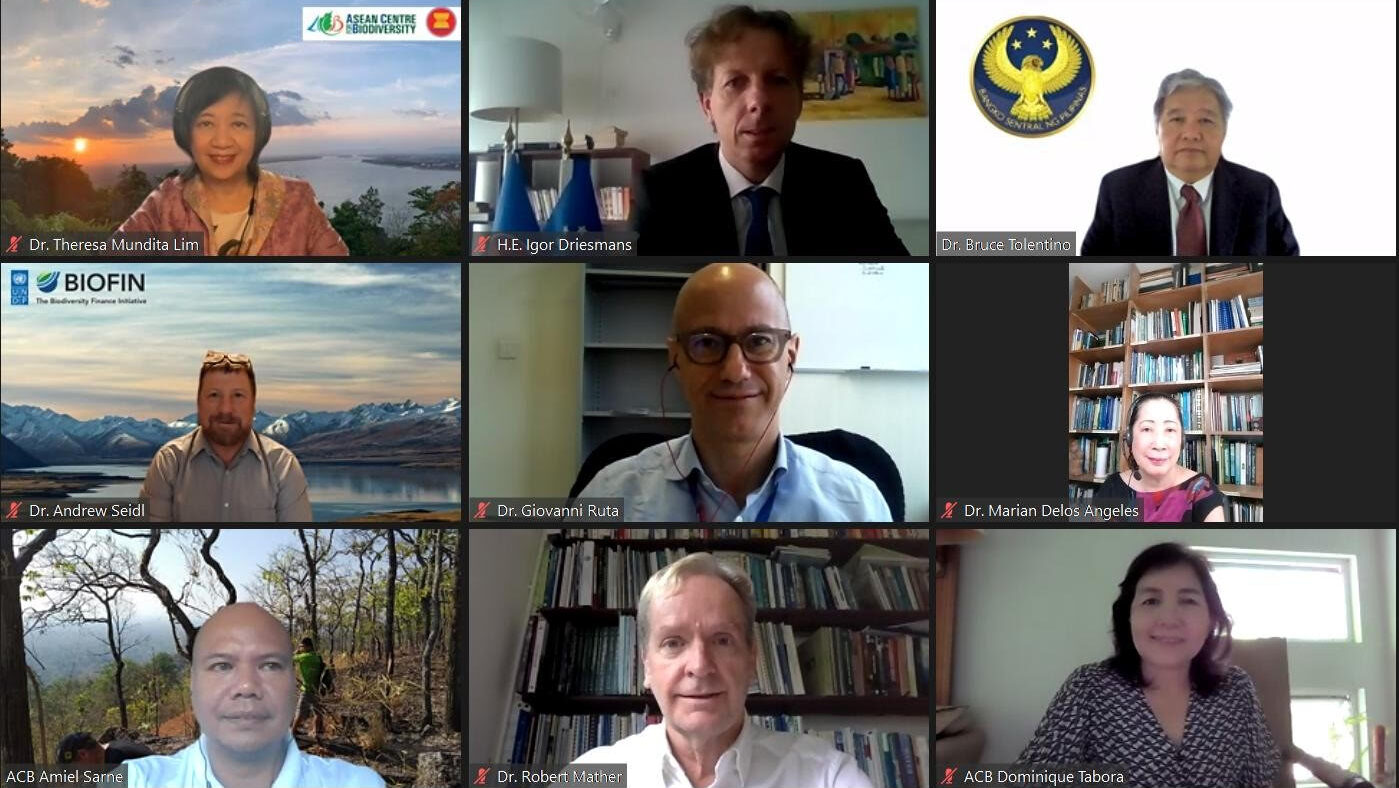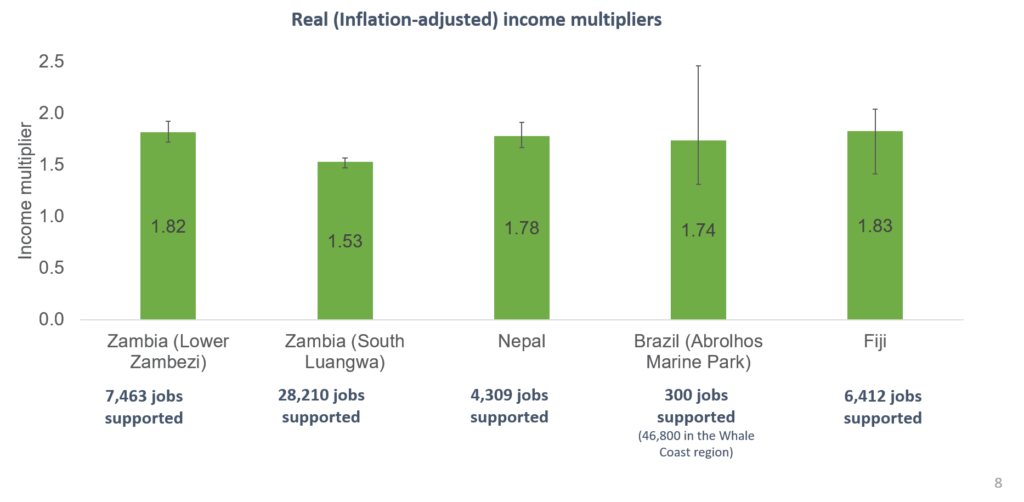“From reflection to action”: Finance sector called for greening economy

Screen-grabbed from the fourth session of the webinar series Economics of Biodiversity
20 August 2021— The financial sector has a huge role to play in greening the economy and driving positive change, particularly in resource allocation and influencing business and policy decisions, the fourth session of the webinar series Economics of Biodiversity emphasised.
“Money is at the very heart of the issue on biodiversity. The financial system determines resource allocation and decides which investment ideas get funded and which ones do not. This makes it a powerful force. It can be a destructive force or it can be a driver of positive change,” the European Union (EU) Ambassador to the ASEAN Igor Driesmans said in his opening remarks.
Driesmans and ACB Executive Director Theresa Mundita Lim opened the webinar series’ fourth and last installment titled Transforming Budget and Financial Institutions: Learning from Existing Work and Sharing Future Plans, which was attended by representatives of various sectors in the ASEAN, including economic planning, finance, and budget agencies.
The Economics of Biodiversity webinar series was supported by the EU, German Development Bank (KfW), and Deutsche Gesellschaft für Internationale Zusammenarbeit (GIZ) GmbH through the Biodiversity Conservation and Management of Protected Areas in ASEAN (BCAMP) Project, Small Grants Programme (SGP), and the Institutional Strengthening of Biodiversity Sector in the ASEAN II Project, respectively.
Lim noted that discussions on the crucial role of the financial sector in protecting nature are timely with the release of the report of the UN Intergovernmental Panel on Climate Change showing that the global temperature is expected to reach or exceed 1.5 degrees Celsius.
“This change in the climate is unprecedented and will likely cause grave consequences to each and everyone of us, disrupting lives, communities, and economies. Protecting nature to stop the catastrophic consequences of climate change needs to be dealt with urgency and earnest collaboration of various sectors,” Lim said.
The past sessions of the webinar series tackled ideas and experiences relating to the broad transitions to sustainable paths laid out in the Dasgupta Review, a groundbreaking analysis on the Economics of Biodiversity led by Professor Sir Partha Dasgupta.
Increasing global investments
In his presentation, Dr. Andrew Seidl, senior technical advisor of the UN Development Programme Biodiversity Finance Initiative (BIOFIN), shared the components of a biodiversity finance plan, which includes the review of policies and actors that influence biodiversity finance, and assessments of biodiversity expenditure and finance needs.
“In the biodiversity finance plan, we identify mechanisms that will help us bridge the gap (in biodiversity expenditures and needs) in the private and public sectors in a prioritised and systematic manner,” Seidl said.
He stressed that 26 countries in the world have completed the Biodiversity Expenditure Review, and four of which are member states of the ASEAN.
Based on the cross-analysis done by BIOFIN, global public biodiversity investments have increased to an average of USD 121 billion annually, or 0.19-0.25 per cent of the global GDP.
Countries with biodiversity hotspots, more protected areas, and more threatened and endangered species should invest more in biodiversity protection.
Likewise, he said investing in biodiversity matters as funds allocated to biodiversity are associated with a reduction in the number of threatened species and the rate of biodiversity loss of about 1 per cent per year.
He added that every USD 1 billion invested in biodiversity results in 0.57 per cent reduction in the proportion of threatened to total species.
‘Means good business’
“Investing in protected areas means good business for local economies,” Dr. Giovanni Ruta, lead environmental economist of the World Bank, stressed in his keynote presentation.
Ruta shared some of the highlights in the country case studies on the economics of protected areas and the study Global Deal for Nature.
The country case studies in Nepal, Fiji, Brazil, and Zambia show the effect of tourists spending a dollar in protected areas––being a “multiplier” that provides significant returns.
An additional dollar spent by visitors raises local incomes in the local economy by USD 1.5 to 1.9 across the five parks. Consistent multipliers also show that a healthy tourism sector provides similar income gains to local households.

Figure 1. Screen-grabbed from the presentation of Dr. Giovanni Ruta, lead environmental economist of the World Bank
For each dollar spent by tourists in the local economy, more income is generated for non-poor households in Nepal, Fiji, and Brazil, and for poor households in Zambia.
In a roundtable discussion, Lao PDR’s Deputy Finance Minister Bounleua Sinxayvoravong and Dr. Dian Lestari, director of the Center for Climate Change Financing and Multilateral Policy in Indonesia, shared developments in their respective countries’ financial institutions, government policies, and the challenges they currently face.
The Lao PDR deputy minister said that in financing the operations in biodiversity, the government supports the mobilisation of domestic and foreign fund sources. Private sectors are also encouraged to be involved in environmental conservation through investments in ecotourism, local communities’ participation during environmental protection activities, among others.
For Indonesia, Lestari noted that it has mainstreamed biodiversity considerations into the country’s budgeting systems in order to allocate financing for environmental and climate actions.
The estimated allocation per year for biodiversity conservation activities is around 0.87 per cent of total government budget, and 4.1 per cent of the total budget on the average for activities.
To augment the financing for biodiversity and close the funding gap, the Indonesian government partnered with organisations to identify and mobilise financing sources.
Under the programme Green Sukuk, Indonesia, since 2018, has managed to mobilise around USD 3.5 billion to finance green projects, including biodiversity conservation.
The entire recorded livestream of the webinar can be accessed on the ACB’s Facebook page. It was moderated by Dr. Bruce Tolentino, member of the monetary board of the Philippines’ central bank.
#
